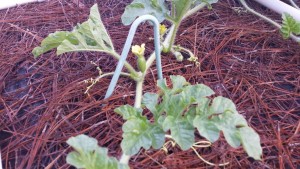
Last month, I introduced you to Chris Kent, a man from Tennessee who has the greenest thumb in the world when it comes to growing giant watermelon. Chris earned that distinction because the 350-pound Carolina Cross that he grew in 2013 is the Guinness World Record-holder for the largest watermelon ever grown. (That’s him with the record-holder on the right.)

Chris has agreed to let me tag along with a series of blog entries about his 2015 crop and chronicle his efforts to break that world record. A lot has happened in the past 30 days, and the watermelon plants have grown from a few tiny sprouts to a series of sprawling vines that are slowly taking over Chris’s backyard.
In the photo at the top of this entry, you can see the 291 Kent watermelon plant, which was photographed in the first blog entry. Chris describes this plant as “a great plant, with vines going in all directions.”
POLLINATING THE PLANTS
There are currently 10 plants that Chris is focusing his attention on. This past weekend, Chris started pollinating the flowers on the plants. Pollination usually occurs naturally by bees, which transport pollen from a male flower and spread it to a female flower. Championship watermelon growers like Chris, however, hand pollinate the flowers so that he can use pollen from only the highest quality male flowers.
To do that, Chris covers the female flower the night before and, when the flower opens the next morning, he pollinates it with pollen from a top-notch male flower. He then covers the female flower again, to prevent bees from bringing pollen in from other watermelon flowers. (Below is a picture of one of Chris’s female flowers that is open and read to be pollinated.)

The pollination process has begun on some of Chris’s plants, but not all of them.
“Not all plants are ready to set fruit yet. I have to wait until the plant is large enough to bear fruit, because it’s not an easy process,” explained Chris. “Two weeks after the flower appears, the plant must be able to put on more than five pounds of weight per day on the watermelon. They grow very fast, and will be over 100 pounds before they are 30 days old.”
In the meantime, there’s plenty of daily upkeep. Chris trains the vines to go in various directions. “I don’t want them all bunched up,” said Chris. “I like to spread them out.” If there’s no rain and the weather is hot, the plants need to be watered daily. A full grown plant needs 20 gallons of water each day, in addition to plant food and soil amendments.
In next month’s blog entry, we’ll discuss how Chris keeps rabbits, mice and other critters away from his plants. We’ll also talk about how he determines which watermelon have Guinness potential, and which ones to cut off the vine to give the biggest ones the best chance at becoming the next world record-holder.
UP NEXT: An interview with a watermelon carver
Remember, all comments left on the blog this month are entered to win our June prize – a set of watermelon dip bowls – so comment as often as you’d like!
Wow, that is a big canvas for watermelon carvers 🙂
thats a watermelon
yep, your right